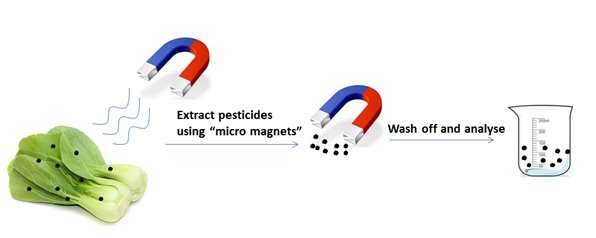Food scientists create novel magnetic nanoparticles for rapid screening of pesticide residue in vegetables

Food scientists from the National University of Singapore (NUS) developed a rapid and highly sensitive screening technique capable of detecting minute amounts of pyrethroids in vegetables, a common type of synthetic pesticide applied on agricultural crops. The innovative strategy makes use of magnetic nanoparticles to simplify pyrethorid extraction, reducing the screening process to under two hours.
Synthetic pesticides such as pyrethorids are widely used in vegetable farming to control agricultural pests. While the use of these pesticides improves crop yield, long-term ingestion of excessive pesticide residues through the consumption of fruits and vegetables that have been subject to pesticide abuse could lead to adverse health effects.
Several methods have since been established to screen vegetable crops for pyrethorid residue. However, they require time consuming and costly procedures such as column filtration and centrifugation, and can take up to six hours to process and analyse a sample.
To simplify the procedures, Assistant Professor Yang Hongshun and his Ph.D. student, Miss Yu Xi, both from the Food Science and Technology Programme at the NUS Faculty of Science, developed polystyrene coated magnetic nanoparticles which can effectively extract pyrethorid residue from vegetable crops for analysis via simple magnetic separation. The nanoparticles are first added into a liquid sample obtained from vegetables, serving as "micro magnets" to attract pyrethroid molecules. Pyrethroids bound on the nanoparticles are then washed off by a small amount of organic solvent and collected for analysis.
This innovation allows analysis to be completed in less than two hours, and is able to detect pyrethroids at a concentration level of as low as 0.02 nanogram per gram of vegetables. The nanoparticles can also be reused up to 30 times, making this screening approach both time and cost efficient.
Asst Prof Yang, said, "Existing screening methods require long processing time and hence it could be challenging to apply such methods to detect pesticide residue in a large batch of samples, which is vital to ensuring food safety. Our method therefore offers a faster and more effective alternative."
This novel screening technique can also be modified for different purposes and holds immense potential for the safety of the food industry.
"With small modifications to the extraction process, this method can be used to detect pyrethroids in other food products such as nuts, fruits and vegetable oils. Modifications can also be made to the coating of the nanoparticles to detect other types of pesticides and chemicals including mycotoxins and antibiotics," said Miss Yu.
Moving forward, the duo will look into expanding the applications of their novel technique to enable screening of different chemical hazards in various food types.
More information: Xi Yu et al. Pyrethroid residue determination in organic and conventional vegetables using liquid-solid extraction coupled with magnetic solid phase extraction based on polystyrene-coated magnetic nanoparticles, Food Chemistry (2016). DOI: 10.1016/j.foodchem.2016.08.115
Journal information: Food Chemistry
Provided by National University of Singapore





















